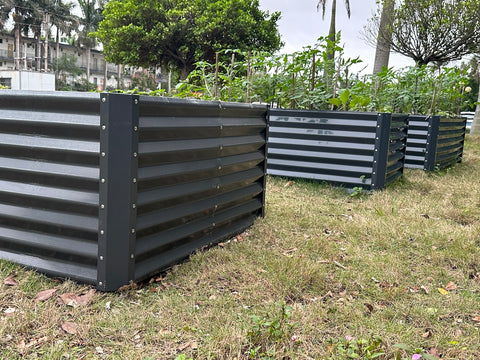As December unfolds and the outdoor world succumbs to winter's chill, there's a refreshing opportunity to bring a burst of vitality indoors – through the cultivation of citrus trees. Indoor citrus trees not only add a touch of greenery to your living space but also offer the promise of homegrown, zesty fruits even in the midst of winter. In this blog, we'll explore the joy of growing indoor citrus trees and provide techniques to ensure your home is infused with the invigorating scent of citrus throughout December.The following content also has some reference value for raised garden beds.
1. Choosing the Right Citrus Varieties
The first step to a successful indoor citrus venture is selecting the right varieties. Some citrus trees are more suited to indoor conditions, such as dwarf or miniature varieties like Meyer lemons, Calamondin oranges, or Key limes. These compact trees are well-adapted to container living.
Growing Technique: Opt for dwarf or miniature citrus trees to accommodate limited indoor space and facilitate easy container gardening.

2. Optimal Indoor Conditions for Citrus Trees
Citrus trees thrive in specific conditions, even when grown indoors. Ensure they receive plenty of sunlight – a south-facing window is ideal. Maintain a temperature range between 60-70°F (15-24°C) during the day and slightly cooler at night. Adequate humidity levels are also crucial for citrus trees.
Growing Technique: Rotate your citrus tree periodically to ensure all sides receive sunlight, and use a humidity tray or humidifier to maintain moisture levels.
3. Choosing the Right Containers
The choice of containers is critical for successful indoor citrus cultivation. Select pots with good drainage to prevent waterlogged soil, which can lead to root rot. Consider using containers with wheels for easy mobility and flexibility in arranging your indoor citrus grove.
Growing Technique: Use a well-draining potting mix specifically formulated for citrus trees to ensure proper aeration and moisture retention.
4. Watering Citrus Trees Indoors
Citrus trees prefer consistently moist but not waterlogged soil. Ensure thorough watering when the upper inch of soil appears dry, and let the excess water drain. Avoid letting the soil dry out completely, as citrus trees are sensitive to both overwatering and underwatering.
Growing Technique: Use a saucer beneath the pot to catch excess water and prevent it from pooling around the roots. Adjust your watering frequency based on the specific needs of your citrus tree.
5. Fertilizing Indoor Citrus Trees
Indoor citrus trees benefit from regular feeding, especially during the growing season. Use a balanced citrus fertilizer, rich in nitrogen, phosphorus, and potassium, to promote healthy foliage, flowering, and fruiting.
Growing Technique: Follow the recommended dosage on the fertilizer package, and apply it every 4-6 weeks during the growing season. Reduce or eliminate fertilizer during the dormant winter months.

6. Pruning for Indoor Citrus Success
Pruning is essential for shaping indoor citrus trees and promoting air circulation. Remove dead or diseased branches, as well as any growth that appears crowded. Pruning encourages a bushier and more compact growth habit.
Growing Technique: Prune your indoor citrus tree in late winter or early spring, just before the growing season begins. Avoid heavy pruning during the dormant winter period.
7. Protecting Indoor Citrus from Pests
Even indoors, citrus trees can attract pests like spider mites or aphids. Regularly inspect your citrus tree for signs of infestation and take preventive measures, such as periodically showering the tree to dislodge pests.
Growing Technique: Use insecticidal soap or neem oil as natural remedies to combat common pests. Quarantine newly acquired plants to prevent introducing pests to your indoor citrus grove.
8. Pollination Assistance for Indoor Citrus
Indoor citrus trees may require assistance with pollination, especially if kept away from outdoor pollinators like bees. Gently shake the branches when the tree is in bloom to encourage pollination.
Growing Technique: Consider using a small, soft paintbrush to transfer pollen between flowers, mimicking the action of pollinating insects.
9. Harvesting Homegrown Citrus
One of the most rewarding aspects of growing indoor citrus trees is harvesting your homegrown fruits. Citrus trees typically take several months to produce ripe fruits, and the harvest season can extend into December and beyond, depending on the variety.
Growing Technique: Harvest fruits when they reach full color and easily detach from the tree with a gentle twist. Enjoy the satisfaction of picking fresh citrus from your indoor grove.
10. Adding Aromatherapy to Your Space
Beyond the tangible fruits, indoor citrus trees contribute to your home's ambiance with their invigorating scent. The fragrance of citrus blossoms and ripe fruits creates a natural and refreshing aromatherapy experience.
Growing Technique: Place your indoor citrus trees in areas where the fragrance can disperse throughout your living space, bringing a touch of the outdoors inside.

Conclusion: December Delight with Indoor Citrus
Indoor citrus trees are not just a source of fresh, homegrown fruits – they are a vibrant addition to your home's decor, an aromatic delight, and a rewarding year-round gardening project. By incorporating these techniques into your indoor citrus cultivation, you can ensure a flourishing grove that brings a zest of freshness to your December and beyond. So, embark on the journey of growing your indoor citrus oasis, and let the vibrancy of citrus trees brighten your home during the winter months.









